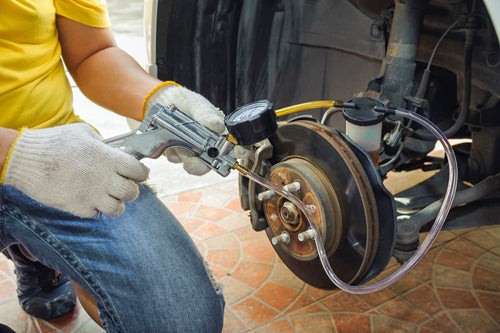Bleeding your car’s brakes is a common maintenance task, often perceived as a two-person job. Think again! This guide provides effective techniques for bleeding master cylinder brakes by yourself, equipping you with the knowledge and confidence to tackle this essential car maintenance procedure solo.
Bleeding brakes is crucial for maintaining a safe and responsive braking system. Air in the brake lines compresses, leading to a spongy brake pedal and reduced braking power. This guide outlines three methods for effectively removing air from your brake system without needing assistance.
Method 1: Bleeding Brakes by Gravity
This slow and steady method leverages gravity to bleed your brakes. Ideal if you’re not pressed for time, it requires minimal equipment.
- Preparation: Ensure your master cylinder reservoir is filled with fresh brake fluid.
- Bleed Screw: Start with the wheel furthest from the master cylinder (usually the right rear). Loosen the bleed screw on the brake caliper or cylinder.
- Gravity’s Work: Allow the brake fluid to drain for at least an hour. Gravity will naturally force air out of the system.
- Close and Repeat: Close the bleed screw and refill the master cylinder. Repeat this process for each wheel, working your way closer to the master cylinder (passenger rear, passenger front, then driver front). Remember to refill the master cylinder after each wheel.
- Final Check: After bleeding all wheels, pump the brake pedal. It should feel firm, indicating successful air removal.
Method 2: Bleeding Brakes with a Bottle and Hose
This method offers a faster alternative to gravity bleeding, utilizing a simple DIY setup.
- DIY Bleed Bottle: Create a bleed bottle using a clean jar or bottle with a lid. Drill two holes in the lid: one for a hose fitting snugly over the bleeder nipple and a smaller air hole.
- Fluid Level: Pour brake fluid into the jar, enough to submerge the hose end, preventing air from re-entering the system.
- Connect and Bleed: Attach the hose to the bleeder nipple and open the screw. Top off the master cylinder and pump the brake pedal several times. Fluid and air bubbles will flow into the bottle.
- Monitor and Repeat: Observe the hose for air bubbles. Once clear, close the bleeder and repeat the process for each wheel, ensuring the master cylinder remains full.
Method 3: Bleeding Brakes with a Vacuum Pump
A vacuum pump offers the fastest and most efficient bleeding method but requires a specialized tool.
- Vacuum Pump Setup: Attach the vacuum pump to the bleeder nipple using a hose and collection bottle (often included with the pump).
- Extract Air and Fluid: With the master cylinder full, use the vacuum pump to draw out old fluid and air from the brake line.
- Close and Repeat: Close the bleed screw and move to the next wheel, repeating the process until all wheels are bled.
Regardless of the chosen method, remember to consult your vehicle’s repair manual for specific instructions and torque specifications for bleed screws. Regularly bleeding your brakes ensures optimal performance and safety on the road. By following these techniques, you can confidently bleed your master cylinder brakes alone, saving time and money.


